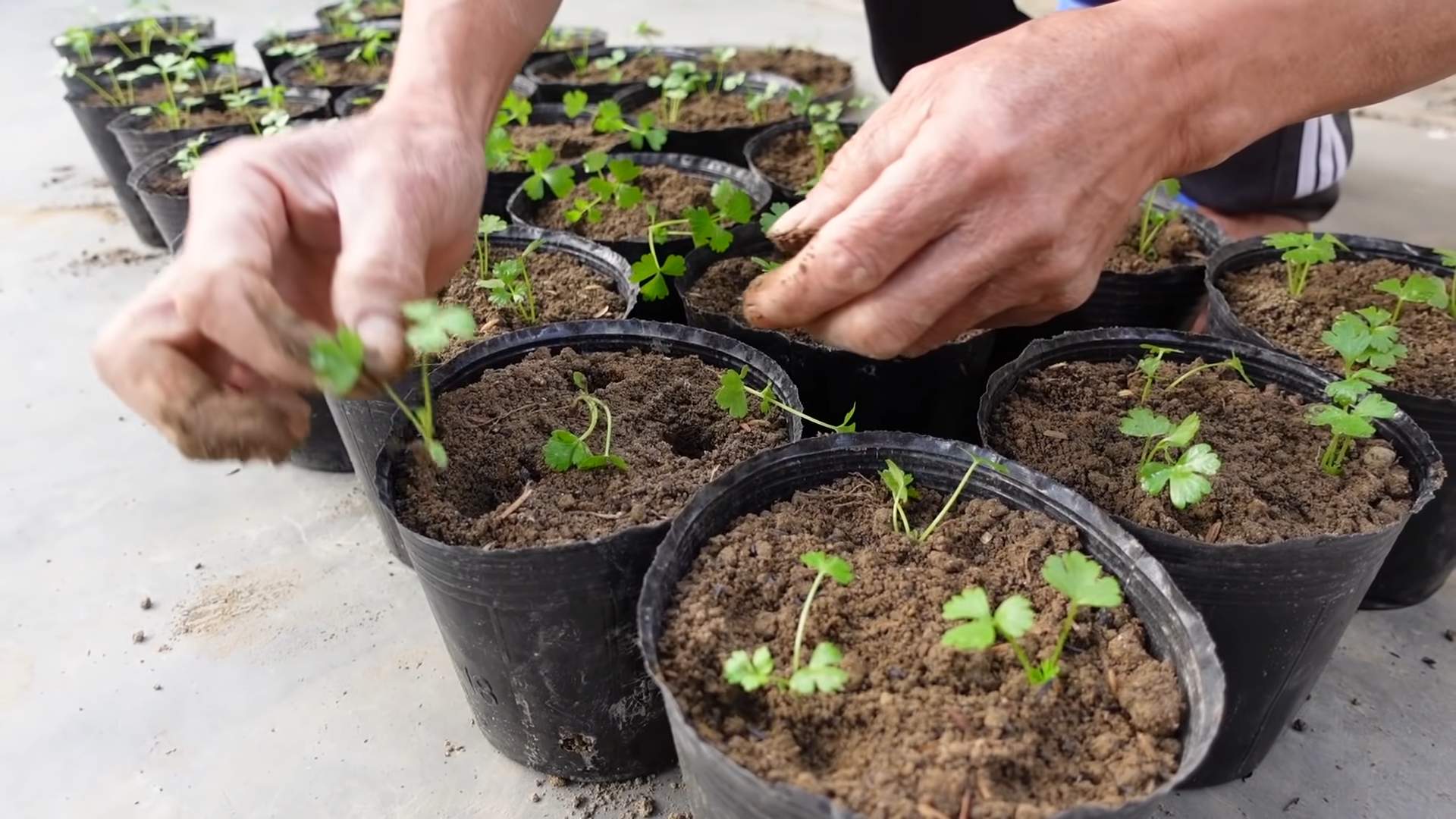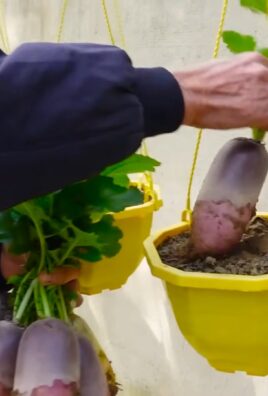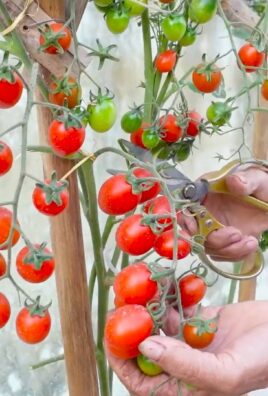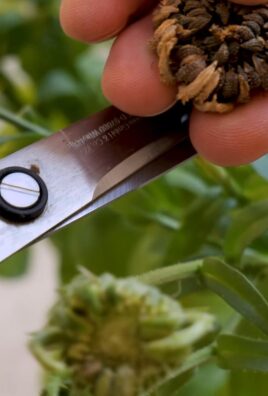Grow Celery Indoors? Absolutely! Imagine fresh, crisp celery stalks just steps away from your kitchen, ready to add a delightful crunch to your salads, soups, and snacks. No more last-minute grocery runs or wilted celery in the crisper drawer. This DIY guide will empower you to cultivate your own thriving celery patch right inside your home.
For centuries, celery has been prized not only for its culinary uses but also for its medicinal properties. Ancient civilizations, including the Egyptians and Romans, recognized its value, using it in various remedies and rituals. Today, we appreciate celery for its refreshing taste and nutritional benefits, but growing it can sometimes feel like a challenge, especially if you lack a traditional garden.
That’s where this DIY trick comes in! Many people struggle with growing celery outdoors due to unpredictable weather, pests, or limited space. But fear not! I’m here to show you how to grow celery indoors successfully, regardless of your gardening experience. This simple and effective method will allow you to enjoy fresh, homegrown celery year-round, saving you money and reducing your reliance on store-bought produce. Let’s get started and unlock the secrets to indoor celery cultivation!

Regrow Celery from Kitchen Scraps: A Simple DIY Guide
Hey there, fellow plant enthusiasts! Ever feel guilty about tossing those celery ends after chopping up the stalks for a snack or soup? Well, I’ve got some fantastic news: you can easily regrow celery from those very scraps! It’s a fun, sustainable project that brings a little bit of the garden indoors, and it’s surprisingly simple. I’m going to walk you through the whole process, step-by-step, so you can enjoy fresh celery leaves (and eventually stalks!) right from your kitchen.
What You’ll Need
Before we dive in, let’s gather our supplies. You probably already have most of these lying around:
* A celery stalk base (the part you usually cut off). Make sure it’s relatively fresh and firm, not mushy or dried out.
* A shallow dish or bowl.
* Water (tap water is fine).
* A sunny windowsill or a spot with good indirect light.
* Potting soil.
* A pot with drainage holes (at least 6 inches in diameter).
* (Optional) Rooting hormone – this can help speed things up, but it’s not essential.
Phase 1: Rooting Your Celery Base
This is where the magic begins! We’re going to coax those celery cells into sprouting roots.
1. Prepare the Celery Base: Carefully trim the bottom of the celery base, removing any brown or dried-out bits. You want a clean, fresh surface for the roots to emerge. I usually cut off about half an inch.
2. Place in Water: Fill your shallow dish with about an inch of water. Place the celery base, cut-side up, in the water. Make sure the water level is high enough to cover the bottom of the base, but not so high that it submerges the entire thing. We want the top part to stay dry to prevent rotting.
3. Find a Sunny Spot: Place the dish on a sunny windowsill or in a location with bright, indirect light. Celery loves light, so the more, the better! Just avoid direct, harsh sunlight, which can scorch the leaves.
4. Change the Water Regularly: This is crucial! Change the water every 1-2 days to keep it fresh and prevent bacteria from growing. I usually do this first thing in the morning. You’ll start to see small roots emerging from the bottom of the celery base within a few days.
5. Be Patient: Root growth can vary depending on the celery variety and environmental conditions. It usually takes about 5-7 days to see noticeable roots, but sometimes it can take a bit longer. Don’t give up! Just keep changing the water and providing plenty of light.
Phase 2: Planting Your Rooted Celery
Once your celery base has developed a good network of roots (about an inch or two long), it’s time to move it to a pot with soil.
1. Prepare the Pot: Fill your pot with well-draining potting soil. Leave about an inch of space between the top of the soil and the rim of the pot. I like to use a mix of potting soil and compost for extra nutrients.
2. Make a Hole: Create a hole in the center of the soil that’s large enough to accommodate the celery base and its roots.
3. Carefully Transplant: Gently remove the celery base from the water and carefully place it in the hole. Make sure the roots are spread out and not bunched together.
4. Cover the Roots: Fill the hole with soil, gently pressing down around the celery base to secure it in place. The top of the celery base should be just above the soil line.
5. Water Thoroughly: Water the soil thoroughly until water drains out of the drainage holes. This will help settle the soil and ensure the roots are properly hydrated.
Phase 3: Caring for Your Growing Celery
Now that your celery is planted, it’s time to provide it with the care it needs to thrive.
1. Light: Continue to provide your celery with plenty of light. A sunny windowsill is still ideal, but you can also use a grow light if you don’t have enough natural light.
2. Watering: Keep the soil consistently moist, but not soggy. Water when the top inch of soil feels dry to the touch. Overwatering can lead to root rot, so be careful not to overdo it. I usually water every 2-3 days, depending on the weather and humidity.
3. Fertilizing: Celery is a heavy feeder, so it benefits from regular fertilization. Use a balanced liquid fertilizer diluted to half strength every 2-3 weeks. Follow the instructions on the fertilizer label.
4. Temperature: Celery prefers cooler temperatures, ideally between 60-70°F (15-21°C). Avoid placing it near heat sources or in direct sunlight during the hottest part of the day.
5. Harvesting: You can start harvesting celery leaves as soon as they are large enough to use. Simply snip off the outer stalks with scissors or a knife. The plant will continue to produce new leaves.
6. Pest Control: Keep an eye out for pests like aphids or spider mites. If you notice any, you can try spraying the plant with insecticidal soap or neem oil. I usually check my plants regularly to catch any problems early.
Troubleshooting
Sometimes, things don’t go exactly as planned. Here are a few common issues you might encounter and how to address them:
* Celery base rotting: This is usually caused by overwatering or not changing the water frequently enough. Make sure the water is fresh and that the top of the celery base is not submerged. If the base is already rotting, you might need to start with a fresh one.
* Slow root growth: This could be due to insufficient light or cold temperatures. Make sure your celery is getting plenty of light and that the temperature is within the ideal range. You can also try using rooting hormone to speed things up.
* Yellowing leaves: This could be a sign of nutrient deficiency. Try fertilizing your celery with a balanced liquid fertilizer.
* Leggy growth: This is usually caused by insufficient light. Move your celery to a brighter location or use a grow light.
From Regrowth to Full Stalks: The Long Game
Okay, let’s be realistic. While you *can* technically regrow celery stalks from a base, it’s a bit of a long shot indoors. The celery you regrow from a base will likely produce smaller, thinner stalks than what you buy at the store. Think of it more as a way to get fresh celery leaves for flavoring soups, salads, and other dishes.
If you’re determined to grow full-sized celery stalks, you’ll need a larger pot (at least 12 inches in diameter), plenty of sunlight, and consistent watering and fertilizing. You might also consider transplanting it outdoors during the warmer months.
However, even if you only get celery leaves, it’s still a rewarding and sustainable project! Plus, it’s a great way to reduce food waste and add a touch of green to your kitchen.
Tips for Success
* Start with a healthy celery base: Choose a base that is firm, fresh, and free from blemishes.
* Use well-draining soil: Celery doesn’t like to sit in soggy soil.
* Provide plenty of light: Celery needs at least 6 hours of sunlight per day.
* Water regularly: Keep the soil consistently moist, but not soggy.
* Fertilize regularly: Celery is a heavy feeder and benefits from regular fertilization.
* Be patient: Growing celery takes time and effort. Don’t get discouraged if you don’t see results immediately.
So, there you have it! Everything you need to know to regrow celery from kitchen scraps. It’s a fun, easy, and rewarding project that anyone can do. Give it a try, and let me know how it goes! Happy growing!

Conclusion
So, there you have it! Growing celery indoors from scraps isn’t just a fun experiment; it’s a surprisingly rewarding way to reduce food waste, enjoy fresh herbs, and add a touch of green to your home. It’s a simple, sustainable practice that connects you to the food you eat in a unique and meaningful way.
Why is this DIY trick a must-try? Because it’s incredibly easy, cost-effective, and environmentally friendly. Instead of tossing those celery bases into the compost (or worse, the trash!), you’re giving them a second life, transforming them into a source of fresh, flavorful celery leaves. Think of the possibilities! You can use these leaves to enhance soups, salads, stir-fries, and countless other dishes. Plus, watching the celery regrow is a fascinating process, especially for kids. It’s a mini-science lesson right in your kitchen!
But the benefits don’t stop there. Growing your own celery indoors allows you to control the growing environment, ensuring that your celery is free from harmful pesticides and chemicals. You know exactly what you’re putting into your body, which is a huge peace of mind. And let’s be honest, there’s something incredibly satisfying about harvesting something you’ve grown yourself, no matter how small.
Ready to take your indoor gardening to the next level? Consider these variations:
* Experiment with different celery varieties: Try regrowing organic celery versus conventional celery to see if there’s a noticeable difference in growth rate or flavor.
* Hydroponics: For a more advanced approach, try growing your celery scraps hydroponically. This involves suspending the base in water with added nutrients, eliminating the need for soil.
* Companion planting: Once your celery has established itself, consider planting it alongside other herbs like parsley or chives. These plants can benefit from each other’s presence, creating a thriving indoor garden ecosystem.
* Seed Starting: Once you have a mature celery plant, you can try to harvest the seeds and start new plants from seed. This is a more involved process, but it can be very rewarding.
Don’t be afraid to experiment and find what works best for you. The beauty of this DIY project is its flexibility and adaptability. Whether you’re a seasoned gardener or a complete beginner, you can successfully grow celery indoors with just a few simple steps.
We wholeheartedly encourage you to give this DIY trick a try. It’s a small change that can make a big difference, both for your wallet and for the environment. And most importantly, it’s a fun and rewarding experience that will bring a little bit of nature into your home.
So, grab that celery base, find a sunny spot, and get ready to watch the magic happen. And once you’ve had success, we’d love to hear about it! Share your experiences, tips, and photos with us in the comments below. Let’s create a community of indoor celery growers and inspire others to embrace this sustainable and delicious practice. Happy growing!
Frequently Asked Questions (FAQ)
Why is my celery not regrowing?
There are several reasons why your celery might not be regrowing as expected. First, ensure the celery base is sitting in water consistently. The water level should be high enough to cover the bottom inch or two of the base. Second, make sure the celery is getting enough sunlight. Celery needs at least 6 hours of sunlight per day to thrive. If you don’t have a sunny window, consider using a grow light. Third, the water quality matters. Use filtered or dechlorinated water to avoid harming the celery. Finally, be patient! It can take a week or two for new growth to appear. If you’ve tried all of these tips and your celery still isn’t regrowing, it might be that the celery base wasn’t viable to begin with. Try starting with a fresh celery base from a different bunch.
How long does it take for celery to regrow indoors?
The time it takes for celery to regrow indoors can vary depending on several factors, including the amount of sunlight, water quality, and temperature. Generally, you should start to see new growth within one to two weeks. After about three to four weeks, you’ll have enough celery leaves to harvest. Keep in mind that you’re primarily growing the leaves, not the full stalks, when regrowing from a base. While the base will produce new stalks, they typically won’t be as thick or robust as the original celery.
Can I grow full-sized celery stalks indoors?
While you can regrow celery from a base indoors, it’s unlikely that you’ll get full-sized celery stalks. The primary goal of regrowing celery indoors is to harvest the leaves, which are flavorful and versatile. To grow full-sized celery stalks, you’ll need a larger container, more space, and more intense light. It’s generally easier to grow full-sized celery outdoors in a garden bed or large pot.
What kind of soil should I use for growing celery indoors?
When transplanting your celery base to soil, use a well-draining potting mix. A mix that’s rich in organic matter is ideal. You can also amend your potting mix with compost or worm castings to provide extra nutrients. Avoid using garden soil, as it can be too heavy and may not drain well, which can lead to root rot.
How often should I water my celery plant?
Water your celery plant regularly, keeping the soil consistently moist but not waterlogged. Check the soil moisture level daily and water when the top inch of soil feels dry to the touch. Avoid letting the soil dry out completely, as this can stress the plant and hinder growth.
What are some common problems when growing celery indoors?
Some common problems when growing celery indoors include yellowing leaves, slow growth, and root rot. Yellowing leaves can be a sign of nutrient deficiency or overwatering. Slow growth can be caused by insufficient sunlight or poor water quality. Root rot is usually caused by overwatering or poor drainage. To prevent these problems, ensure your celery plant is getting enough sunlight, water it properly, and use a well-draining potting mix.
How do I harvest celery leaves?
Harvest celery leaves by snipping them off with scissors or pruning shears. Start by harvesting the outer leaves first, leaving the inner leaves to continue growing. You can harvest leaves as needed, whenever you want to add them to your dishes. Regular harvesting will also encourage the plant to produce more leaves.
Can I use fertilizer to help my celery grow?
Yes, you can use fertilizer to help your celery grow. Use a balanced liquid fertilizer diluted to half strength. Fertilize your celery plant every two to four weeks during the growing season. Avoid over-fertilizing, as this can burn the roots.
Is growing celery indoors from scraps sustainable?
Yes, growing celery indoors from scraps is a very sustainable practice. It reduces food waste by giving celery bases a second life. It also reduces your reliance on store-bought celery, which can save you money and reduce your carbon footprint.
What if my celery base starts to rot?
If your celery base starts to rot, it’s likely due to overwatering or poor water quality. Remove the rotting base immediately and start with a fresh celery base. To prevent rotting, ensure the water is changed regularly and that the celery base is not sitting in stagnant water. Also, make sure the container you’re using has good drainage.




Leave a Comment